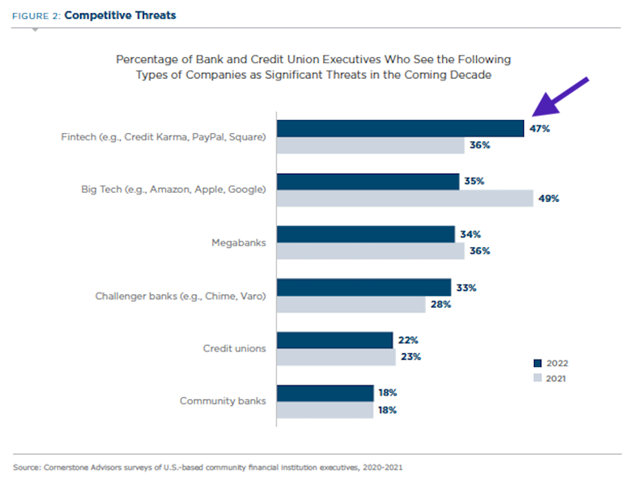We support community and regional banks with the technology ecosystem and support they need to thrive today and in the future.
We help credit unions serve members at their moments of need and on the channel of their choice as their financial lives evolve.
We deliver the insight and technology ecosystem that new banks need – from meeting initial business goals to achieving long-term strategic success.
We help fintechs expand their reach and deliver their innovative solutions to a broader financial ecosystem.
We empower businesses to expedite payments processing, improve cash flow, and manage financials with industry-leading technology.
Playing to Win: Helping Financial Institutions Capitalize on Ecosystem Disruption
We are always innovating to help solve for the needs and challenges of people at financial institutions and their accountholders.
Protecting your bottom line starts with empowering the financial health of your consumer and business accountholders.
Competing for business accountholders in today's environment requires a whole new strategy.
Improving productivity and operating efficiencies is an industry-wide goal, challenging financial institutions to transform the way they do business.
There are challenges across the industry impacting financial institutions’ ability to generate and grow traditional sources of revenue.
Effectively managing enterprise risk has become more complex and challenging than ever.
Gain new accountholders and avoid expensive attrition by delivering a stellar experience in a competitive landscape.
Is Your Organization's Financial Health Leaving You Vulnerable and At Risk?
Jack Henry Rapid Transfers™ – Swift Money Movement with Advanced Security
Read MoreFintech in a Flash: 11 Big Questions to Help You Develop a Modern Payments Strategy
Read MoreSuccess Has a Low Efficiency Ratio
Read MoreInformation Security and Risk Management: Trends and Threats
Read MoreAll-Digital Lending Capabilities | Multiple Loan Types
Read MoreMeet Jack Henry Financial Crimes Defender
Read MoreThe Really Big Small Business Opportunity
Read More6 Tips for How to Improve the Customer & Member Experience (CX)
Read More7 Things to Improve Your Accountholders' Financial Health
Read MoreOur advocacy of community and regional financial institutions is rooted in the belief that the world is better with you in it.
People are at the center of everything we do – and it starts with our associates.
Meet Jack Henry's Leadership Team
We are always looking for talented professionals to join our team. Explore open opportunities.
Jack Henry has long incorporated a commitment to corporate sustainability into the way we do business. Learn about our priorities.
We are dedicated to our stakeholders and delivering a strong return on investment and long-term sustainability for our business model.
Our Purpose and Mission
Find everything you may need to support your financial institution.
Get more accountholders using your solutions with free, ready-to-use materials that make maximizing your technology investments easy.
Stay on top of industry trends with insights from authors who are well-versed on the inner workings of the fintech industry.
Use Real Consumer Insights to Guide Your Next Move With Confidence
We support community and regional banks with the technology ecosystem and support they need to thrive today and in the future.
We help credit unions serve members at their moments of need and on the channel of their choice as their financial lives evolve.
We deliver the insight and technology ecosystem that new banks need – from meeting initial business goals to achieving long-term strategic success.
We help fintechs expand their reach and deliver their innovative solutions to a broader financial ecosystem.
We empower businesses to expedite payments processing, improve cash flow, and manage financials with industry-leading technology.
Playing to Win: Helping Financial Institutions Capitalize on Ecosystem Disruption
We are always innovating to help solve for the needs and challenges of people at financial institutions and their accountholders.
Protecting your bottom line starts with empowering the financial health of your consumer and business accountholders.
Competing for business accountholders in today's environment requires a whole new strategy.
Improving productivity and operating efficiencies is an industry-wide goal, challenging financial institutions to transform the way they do business.
There are challenges across the industry impacting financial institutions’ ability to generate and grow traditional sources of revenue.
Effectively managing enterprise risk has become more complex and challenging than ever.
Gain new accountholders and avoid expensive attrition by delivering a stellar experience in a competitive landscape.
Is Your Organization's Financial Health Leaving You Vulnerable and At Risk?
Our advocacy of community and regional financial institutions is rooted in the belief that the world is better with you in it.
People are at the center of everything we do – and it starts with our associates.
Meet Jack Henry's Leadership Team
We are always looking for talented professionals to join our team. Explore open opportunities.
Jack Henry has long incorporated a commitment to corporate sustainability into the way we do business. Learn about our priorities.
We are dedicated to our stakeholders and delivering a strong return on investment and long-term sustainability for our business model.
Our Purpose and Mission
Find everything you may need to support your financial institution.
Get more accountholders using your solutions with free, ready-to-use materials that make maximizing your technology investments easy.
Stay on top of industry trends with insights from authors who are well-versed on the inner workings of the fintech industry.
Use Real Consumer Insights to Guide Your Next Move With Confidence
Jack Henry Rapid Transfers™ – Swift Money Movement with Advanced Security
Read MoreFintech in a Flash: 11 Big Questions to Help You Develop a Modern Payments Strategy
Read MoreInformation Security and Risk Management: Trends and Threats
Read MoreAll-Digital Lending Capabilities | Multiple Loan Types
Read MoreMeet Jack Henry Financial Crimes Defender
Read MoreThe Really Big Small Business Opportunity
Read More6 Tips for How to Improve the Customer & Member Experience (CX)
Read More7 Things to Improve Your Accountholders' Financial Health
Read More

